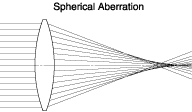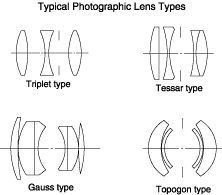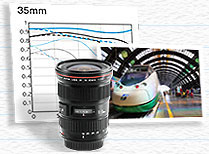 Shooting distance
(camera distance) Shooting distance
(camera distance) |
 |
|
The distance from the film plane
(focal plane) to the subject. The position of the film
plane is indicated on the top of most cameras by a “
 “
symbol. “
symbol. |
 Spherical
aberration Spherical
aberration |
 |
 |
This aberration exists to some degree
in all lenses constructed entirely of spherical
elements. Spherical aberration causes parallel light
rays passing through the edge of a lens to converge at a
focal point closer to the lens than light rays passing
through the center of the lens. (The amount of focal
point shift along the optical axis is called
longitudinal spherical aberration.) The degree of
spherical aberration tends to be larger in
large-aperture lenses. A point image affected by
spherical aberration is sharply formed by light rays
near the optical axis but is affected by flare from the
peripheral light rays (this flare is also called halo,
and its radius is called lateral spherical aberration).
As a result, spherical aberration affects the entire
image area from the center to the edges, and produces a
soft, low-contrast image which looks as if covered with
a thin veil. Correction of spherical aberration in
spherical lenses is very difficult. Although commonly
carried out by coming two lenses-one convex and one
concave-based on light rays with a certain height of
incidence (distance from the optical axis), there is a
limit to the degree of correction possible using
spherical lenses, so some aberration always remains.
This remaining aberration can be largely eliminated by
stopping down the diaphragm to cut the amount of
peripheral light. With large aperture lenses at full
aperture, the only effective way to thoroughly
compensate spherical aberration is to use an aspherical
lens element. |
 Stop/diaphragm/aperture Stop/diaphragm/aperture |
 |
|
The opening which adjusts the
diameter of the group of light rays passing through the
lens. In interchangeable lenses used with single lens
reflex cameras, this mechanism is usually constructed as
an iris diaphragm consisting of several blades which can
be moved to continuously vary the opening diameter. With
conventional SLR camera lenses, the aperture is adjusted
by turning an aperture ring on the lens barrel. With
modern camera lenses, however, aperture adjustment is
commonly controlled by operating an electronic dial on
the camera body. |
 Subject
distance Subject
distance |
 |
|
The distance from the lens’ front
principal point to the subject. |
 Super Spectra
coating Super Spectra
coating |
 |
|
All EF lenses are coated in
accordance with Canon’s own standards, which are even
more strict than the CCI tolerances set by the ISO
(International Standards Organization), and the variety
of single and multilayer coatings used are selected to
optimally match the refraction of the lens to which it
is being applied. Named Super Spectra coating by Canon,
this process features a high permeation rate,
ultraviolet ray filtering, highly durable surface
hardness and features and stable characteristics. The
superior imaging characteristics realized by these
exacting coating procedures includes sharp, vivid images
with high contrast, uniform color balance throughout the
EF lens lineup, and true color reproduction that does
not change over years of use. |
 Super UD
lenses Super UD
lenses |
 |
|
The high cost of synthetic fluorite
crystal production makes fluorite lenses extremely
expensive. One answer was found in the latter half of
the 1970’s with the appearance of UD (ultra low
dispersion) glass that could provide characteristics
similar to fluorite but at a lower cost. While the
indexes of refraction and dispersion of UD glass do not
equal that of fluorite, they are significantly lower
than those of other types of optical glass. Moreover, UD
glass does display partial dispersion characteristics
similar to fluorite. The selection of the proper lens
element combination in consideration of the intended
focal length and other factors can provide close to the
same effect as fluorite, (two UD lens elements are
equivalent to one fluorite element). Another
breakthrough was made in 1993 when Super UD glass was
introduced as a new material that achieves almost the
same performance as fluorite while achieving a new
balance of greater cost reduction and even higher
quality. |
 Superior quality
across the total image area Superior quality
across the total image area |
 |
|
To achieve a high level of sharpness
both at the center and out to the edges of an image when
shooting with a telephoto lens, it is desirable for the
index of refraction of the front convex lens element to
be as small as possible. Accordingly, the use of
fluorite with its low index of refraction effectively
improves image quality over the total image area.
|
 Symmetrical type
lens Symmetrical type
lens |
 |
 |
In this type of lens, the lens group
behind the diaphragm has nearly the same configuration
and shape as the lens group in front of the diaphragm.
Symmetrical lenses are further classified into various
types such as the Gauss type, triplet type, Tessar type,
Topogon type and orthometer type. Of these, the Gauss
type and its derivations is the most typical
configuration used today because • its symmetrical
design allows well-balanced correction of all types of
aberrations, and • a comparatively long back focus can
be achieved. The Canon 50mm f/1.8 released back in 1951
succeeded in eliminating the comatic aberration which
was the sole weak point of Gauss type lenses of that
day, and thus became famous as a historical landmark
lens due to the remarkable improvement in performance it
afforded. Canon still uses a Gauss type construction in
current lenses such as the EF 50mm f/1.8 II, EF 50mm
f/1.4 USM and EF 85mm f/1.2L USM. The Tessar and triplet
type symmetrical configurations are commonly used today
in compact cameras equipped with single focal length
lenses. |
 Telephoto
ratio Telephoto
ratio |
 |
|
The ratio between the overall length
of a telephoto lens and its focal length is called the
telephoto ratio. Put another way, it is the value of the
distance from the apex of the frontmost lens element to
the focal plane divided by the focal length. For
telephoto lenses, this value is less than one. For
reference, the telephoto ratio of the EF 300mm f/2.8L
USM is 0.91 , and that of the EF 600mm f/4L USM is 0.78.
|
 Telephoto type
(teletype) lens Telephoto type
(teletype) lens |
 |
|
With general photographic lenses, the
overall length of a lens (the distance from the apex of
the frontmost lens element to the focal plane) is longer
than its focal length. This is not usually the case with
lenses of particularly long focal length, however, since
using a normal lens construction would result in a very
large, unwieldy lens. To keep the size of such a lens
manageable while still providing a long focal length, a
concave (negative) lens assembly is placed behind the
main convex (positive) lens assembly, resulting in a
lens which is shorter than its focal length. Lenses of
this type are called telephoto lenses. In a telephoto
lens, the second principal point is located in front of
the frontmost lens element. |
 Thorough elimination
of the secondary spectrum Thorough elimination
of the secondary spectrum |
 |
|
When a convex fluorite lens is
combined with a concave wide-dispersion optical glass
lens to correct red and blue wavelengths, the partial
dispersion characteristics of the fluorite also
effectively compensate the green wavelength as well.
This greatly reduces the presence of secondary spectrum
and brings all three wavelengths ~ red, green and blue ~
together at the same focal point to realize virtually
ideal chromatic aberration compensation, (apochromatic
performance). |
 UD glass lenses UD glass lenses |
 |
|
Lenses made from fluorite are
extremely expensive due to the high cost of synthetic
fluorite crystal production. UD (ultra low dispersion)
glass made an appearance in the latter half of the
1970’s, delivering a special optical glass which could
provide characteristics similar to fluorite but at a
lower cost and thereby answering another desire of lens
designers. While the index of refraction and dispersion
of UD glass are not as low as fluorite, they are
significantly lower than other types of optical glass.
Moreover, UD glass does display similar partial
dispersion characteristics. The selection of the proper
lens element combination in consideration of the
intended focal length and other factors can provide
close to the same effect as fluorite, (two UD lens
elements are equivalent to one fluorite element). Super
UD glass was introduced in 1993 as a new material that
achieves almost the same performance as fluorite while
achieving a new balance of cost reduction and higher
quality. |
 USM (Ultrasonic
Motor) USM (Ultrasonic
Motor) |
 |
|
Canon became the first camera maker
to apply the use of an advanced USM (Ultrasonic Motor)
in 1987 when the EF 300mm f/2.8L USM amazed the world
with its silent, super-fast autofocus performance. Then,
in 1990, Canon developed the lower cost ring-type USM
could be used in a variety of more affordable lenses.
This feat was followed in 1992 by the development of a
new type of micro USM that enabled the automation of
production. Every day Canon comes closer to realizing
the goal of equipping every EF lens with a USM. Features
of the ring-type USM include its ability to easily
achieve the low-speed, high-torque characteristics
needed to realize direct drive. Large holding torque
means the disc brake automatically holds the lens in
place when the motor is stopped. Its construction is
extremely simple, operation is virtually noise-free, and
it demonstrates excellent start/stop response and
control. High efficiency and low power consumption allow
the lens to be powered by the camera’s battery. The
motor’s ring shape is optimally suited to lens barrel
applications and its low rotation speed is ideal for
lens drive purposes. Rotation speed control covers a
wide variable range from 0.2 rpm to 80 rpm to realize
high-precision, high-speed lens drive control.
Variable-sensitivity electronic manual focus is also
available. The broad operating temperature range of
-30ºC to +60ºC (-22ºF to 140ºF) ensures stable operation
even in severe environments. And, all lens drive control
is performed by the microprocessor housed within the
lens. More
information |
 |
  |
 |
![]()





